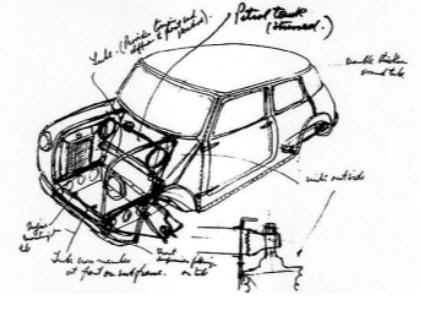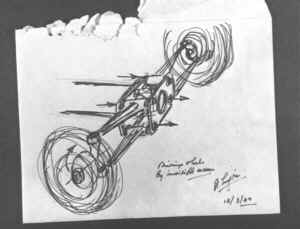|
|
|
|
|
|
'Mini facts I'
Sir Alec Issigonis, the designer of the Mini, was also responsible for much of the design work on Britain's first million selling car, the Morris Minor.   In March 1957, less than 30 months before the Mini was unveiled to the
public, Leonard Lord authorised Issigonis to start on preliminary designs. In March 1957, less than 30 months before the Mini was unveiled to the
public, Leonard Lord authorised Issigonis to start on preliminary designs. The Mini was at one stage going to be called the Austin Newmarket. The universal joints used in the Mini were produced from a design used for submarine conning-tower control gear. Today most of the world's front-wheel drive cars employ this type of universal joint. The first 'mass produced' Mini, 621 AOK, now housed at the Heritage Motor Centre, was hand assembled by Longbridge foreman Albert Green in just seven hours in early 1959. There are just over 3,000 screws, nuts and bolts on a Mini. The purchase price of the 1959 Mini was �496 including tax when it was launched to the public on 26th August 1959.  The Longbridge Mini was launched with the name Austin Seven (before switching to Austin Mini in 1961) and the Cowley produced
version was called the Morris Mini-Minor. This tradition continued until 1969 when both names were dropped and the Mini became a brand in it's own right. The Longbridge Mini was launched with the name Austin Seven (before switching to Austin Mini in 1961) and the Cowley produced
version was called the Morris Mini-Minor. This tradition continued until 1969 when both names were dropped and the Mini became a brand in it's own right. 
In 1959, the Longbridge assembly line was 220 yards long. There were 57 workstations on the assembly line. Each task took two minutes 24 seconds, making a little over two hours for each car. > By 1960, on average 400 Minis were being produced each day at Longbridge while the day shift which assembled 180 Minis consisted of just 57 men. After just three years of production on 12th December 1962, the 500,000th Mini rolled off the production line. The millionth Mini was produced in 1965, the second millionth in 1969, the third millionth in 1972, the four millionth in 1976 and the five millionth in 1986.
Alec Issigonis – ‘the man behind the Mini’
Sir Alec Issigonis created the Mini, he was a man with a similar
imagination for technical matters as Leonardo da Vinci, and Issigonis and the Mini are Alexander Arnold Constantine Issigonis was born in the
Greek city of Smyrna (today called Izmir and now part of Turkey) in 1906, to a Bavarian
mother, while his father was a Briton of Greek descendants. In 1922 Issigonis came to
England with his widowed mother and after setting up home in London, Issigonis enrolled at
Battersea Polytechnic to study automotive engineering where he graduated in 1928. After a
number of years working on projects at a London design office and later suspension
development work for the Rootes Group, he furthered his suspension credentials at Morris The first project was a rear wheel drive family saloon, where Issigonis headed a small team, just 8 men, devoted to advanced product design, which included Jack Daniels, a brilliant draughtsman who had worked with Issigonis at Morris before the war and had done the detail work on the Minor. However this and other projects were promptly dropped in March 1957 when a more important brief cropped up. The Suez crisis in November 1956, which was the result of Egypt’s President Nasser closing the Canal and Syria cutting the main oil pipeline that crossed their country had ushered in petrol rationing and as such the mostly German produced (motorcycle-engined, three and four wheeled, plastic-bodied) bubble cars were starting to become a common sight on Britain’s roads. The sight of these bubble cars offended Sir Leonard Lord and he reckoned that a small economical car did not have to be cramped and crude and told Issigonis so. His requirements were simple: BMC’s small car had to be a full four seater, use an existing engine, be smaller than any other car the company currently produced and should be introduced at the earliest possible opportunity. Thanks to the brilliance of Issigonis and his small team, and the complete commitment to the project by Sir Leonard Lord, the Mini was actually ready in two years and one month.
Alec Issigonis – ‘the latter years’Official recognition for Issigonis came with a CBE in 1964, followed by a well-deserved knighthood in 1969. However his influence ended with the formation of BLMC and he retired in 1972, but he never stopped working and remained as a consultant to BL and Rover until his death in October 1988. Saturday 18th November 2006 marked Alec Issigonis's 100th Birthday and a month or so earlier the Motor Heritage Centre at Gaydon, Warwickshire held a Centenary Celebration in his honour. All his many motoring achievements were invited but it was the original 1959-2000 Mini that made up the vast majority of vehicles on the rally field and considering there was a wide variety of ages present from children to pensioners, I'm sure that Alec Issigonis would have been very proud!
|